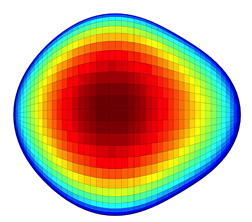Home > Press > Scientists demonstrate pear shaped atomic nuclei
 |
| The shape of 224Ra deduced from the CERN measurements |
Abstract:
Scientists at the University of Liverpool have shown that some atomic nuclei can assume the shape of a pear which contributes to our understanding of nuclear structure and the underlying fundamental interactions.
Scientists demonstrate pear shaped atomic nuclei
Liverpool, UK | Posted on May 9th, 2013Most nuclei that exist naturally are not spherical but have the shape of a rugby ball. While state-of-the-art theories are able to predict this, the same theories have predicted that for some particular combinations of protons and neutrons, nuclei can also assume very asymmetric shapes, like a pear where there is more mass at one end of the nucleus than the other.
The experimental observation of nuclear pear shapes is important for understanding the theory of nuclear structure and for helping with experimental searches for electric dipole moments (EDM) in atoms.
The Standard Model of particle physics predicts that the value of the EDM is so small that it lies well below the current observational limit. However, many theories that try to refine this model predict EDMs that should be measurable. In order to test these theories the EDM searches have to be improved and the most sensitive method is to use exotic atoms whose nucleus is pear-shaped. Quantifying this shape will therefore help with experimental programmes searching for atomic EDMs.
Professor Peter Butler, from the University's Department of Physics who carried out the measurements, said: "Our findings contradict some nuclear theories and will help refine others. The measurements will also help direct the searches for atomic EDMs currently being carried out in North America and in Europe, where new techniques are being developed to exploit the special properties of radon and radium isotopes.
"Our expectation is that the data from our nuclear physics experiments can be combined with the results from atomic trapping experiments measuring EDMs to make the most stringent tests of the Standard Model, the best theory we have for understanding the nature of the building blocks of the universe."
Most nuclear isotopes predicted to have pear shapes have been out of reach of experimental techniques to measure them.
Now, at the ISOLDE facility at CERN, beams of very heavy, radioactive nuclei can be produced in high-energy proton collisions with a uranium carbide target. They are then selectively extracted using their chemical and physical properties before being accelerated to 8% of the speed of light and allowed to impinge on a target foil of isotopically pure nickel, cadmium or tin.
When this happens the relative motion of the heavy accelerated nucleus and the target nucleus creates an electromagnetic impulse that excites the nuclei. By studying the details of this excitation process it is possible to understand the nuclear shape.
This method has been used successfully to study the shape of short-lived isotopes 220Rn and 224Ra. The data show that while 224Ra is pear-shaped, 220Rn does not assume the fixed shape of a pear but rather vibrates about this shape.
####
For more information, please click here
Contacts:
Sarah Stamper
01-517-943-044
Copyright © University of Liverpool
If you have a comment, please Contact us.Issuers of news releases, not 7th Wave, Inc. or Nanotechnology Now, are solely responsible for the accuracy of the content.
| Related Links |
![]() The findings are published in Nature:
The findings are published in Nature:
| Related News Press |
Physics
![]() Simulating magnetization in a Heisenberg quantum spin chain April 5th, 2024
Simulating magnetization in a Heisenberg quantum spin chain April 5th, 2024
News and information
![]() Simulating magnetization in a Heisenberg quantum spin chain April 5th, 2024
Simulating magnetization in a Heisenberg quantum spin chain April 5th, 2024
![]() NRL charters Navy’s quantum inertial navigation path to reduce drift April 5th, 2024
NRL charters Navy’s quantum inertial navigation path to reduce drift April 5th, 2024
![]() Discovery points path to flash-like memory for storing qubits: Rice find could hasten development of nonvolatile quantum memory April 5th, 2024
Discovery points path to flash-like memory for storing qubits: Rice find could hasten development of nonvolatile quantum memory April 5th, 2024
Discoveries
![]() Chemical reactions can scramble quantum information as well as black holes April 5th, 2024
Chemical reactions can scramble quantum information as well as black holes April 5th, 2024
![]() New micromaterial releases nanoparticles that selectively destroy cancer cells April 5th, 2024
New micromaterial releases nanoparticles that selectively destroy cancer cells April 5th, 2024
![]() Utilizing palladium for addressing contact issues of buried oxide thin film transistors April 5th, 2024
Utilizing palladium for addressing contact issues of buried oxide thin film transistors April 5th, 2024
Announcements
![]() NRL charters Navy’s quantum inertial navigation path to reduce drift April 5th, 2024
NRL charters Navy’s quantum inertial navigation path to reduce drift April 5th, 2024
![]() Discovery points path to flash-like memory for storing qubits: Rice find could hasten development of nonvolatile quantum memory April 5th, 2024
Discovery points path to flash-like memory for storing qubits: Rice find could hasten development of nonvolatile quantum memory April 5th, 2024
Interviews/Book Reviews/Essays/Reports/Podcasts/Journals/White papers/Posters
![]() Simulating magnetization in a Heisenberg quantum spin chain April 5th, 2024
Simulating magnetization in a Heisenberg quantum spin chain April 5th, 2024
![]() Discovery points path to flash-like memory for storing qubits: Rice find could hasten development of nonvolatile quantum memory April 5th, 2024
Discovery points path to flash-like memory for storing qubits: Rice find could hasten development of nonvolatile quantum memory April 5th, 2024
|
|
||
|
|
||
| The latest news from around the world, FREE | ||
|
|
||
|
|
||
| Premium Products | ||
|
|
||
|
Only the news you want to read!
Learn More |
||
|
|
||
|
Full-service, expert consulting
Learn More |
||
|
|
||








